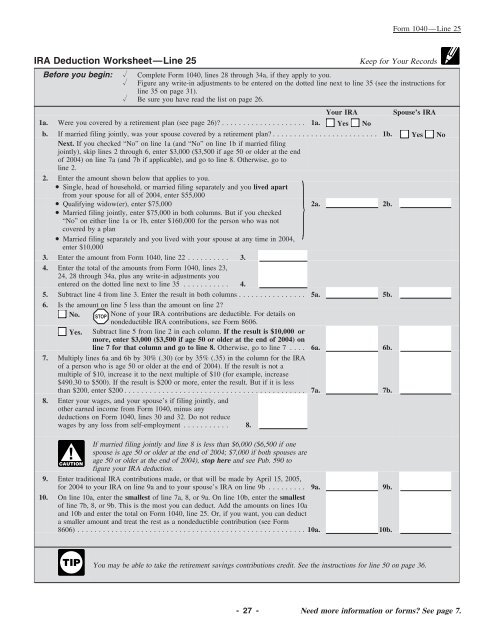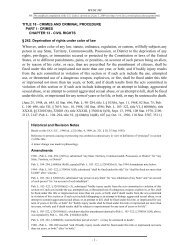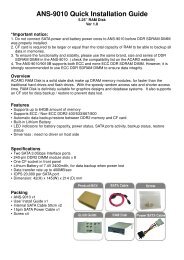2004 Instructions for Form 1040 (ALL) - Supreme Law Firm
2004 Instructions for Form 1040 (ALL) - Supreme Law Firm
2004 Instructions for Form 1040 (ALL) - Supreme Law Firm
Create successful ePaper yourself
Turn your PDF publications into a flip-book with our unique Google optimized e-Paper software.
<strong>Form</strong> <strong>1040</strong>—Line 25<br />
IRA Deduction Worksheet—Line 25<br />
Keep <strong>for</strong> Your Records<br />
Be<strong>for</strong>e you begin: Complete <strong>Form</strong> <strong>1040</strong>, lines 28 through 34a, if they apply to you.<br />
Figure any write-in adjustments to be entered on the dotted line next to line 35 (see the instructions <strong>for</strong><br />
line 35 on page 31).<br />
Be sure you have read the list on page 26.<br />
Your IRA Spouse’s IRA<br />
1a. Were you covered by a retirement plan (see page 26)? .................... 1a. Yes No<br />
b. If married filing jointly, was your spouse covered by a retirement plan? ......................... 1b. Yes No<br />
Next. If you checked “No” on line 1a (and “No” on line 1b if married filing<br />
jointly), skip lines 2 through 6, enter $3,000 ($3,500 if age 50 or older at the end<br />
of <strong>2004</strong>) on line 7a (and 7b if applicable), and go to line 8. Otherwise, go to<br />
line 2.<br />
2. Enter the amount shown below that applies to you.<br />
• Single, head of household, or married filing separately and you lived apart<br />
from your spouse <strong>for</strong> all of <strong>2004</strong>, enter $55,000<br />
• Qualifying widow(er), enter $75,000<br />
• Married filing jointly, enter $75,000 in both columns. But if you checked<br />
“No” on either line 1a or 1b, enter $160,000 <strong>for</strong> the person who was not<br />
covered by a plan<br />
2a. 2b.<br />
• Married filing separately and you lived with your spouse at any time in <strong>2004</strong>,<br />
enter $10,000<br />
3. Enter the amount from <strong>Form</strong> <strong>1040</strong>, line 22 .......... 3.<br />
4. Enter the total of the amounts from <strong>Form</strong> <strong>1040</strong>, lines 23,<br />
24, 28 through 34a, plus any write-in adjustments you<br />
entered on the dotted line next to line 35 ........... 4.<br />
5. Subtract line 4 from line 3. Enter the result in both columns ................ 5a. 5b.<br />
6. Is the amount on line 5 less than the amount on line 2?<br />
No. STOP<br />
None of your IRA contributions are deductible. For details on<br />
nondeductible IRA contributions, see <strong>Form</strong> 8606.<br />
Yes. Subtract line 5 from line 2 in each column. If the result is $10,000 or<br />
more, enter $3,000 ($3,500 if age 50 or older at the end of <strong>2004</strong>) on<br />
line 7 <strong>for</strong> that column and go to line 8. Otherwise, go to line 7 .... 6a. 6b.<br />
7. Multiply lines 6a and 6b by 30% (.30) (or by 35% (.35) in the column <strong>for</strong> the IRA<br />
of a person who is age 50 or older at the end of <strong>2004</strong>). If the result is not a<br />
multiple of $10, increase it to the next multiple of $10 (<strong>for</strong> example, increase<br />
$490.30 to $500). If the result is $200 or more, enter the result. But if it is less<br />
than $200, enter $200 ........................................... 7a. 7b.<br />
8. Enter your wages, and your spouse’s if filing jointly, and<br />
other earned income from <strong>Form</strong> <strong>1040</strong>, minus any<br />
deductions on <strong>Form</strong> <strong>1040</strong>, lines 30 and 32. Do not reduce<br />
wages by any loss from self-employment ........... 8.<br />
!<br />
CAUTION<br />
If married filing jointly and line 8 is less than $6,000 ($6,500 if one<br />
spouse is age 50 or older at the end of <strong>2004</strong>; $7,000 if both spouses are<br />
age 50 or older at the end of <strong>2004</strong>), stop here and see Pub. 590 to<br />
figure your IRA deduction.<br />
9. Enter traditional IRA contributions made, or that will be made by April 15, 2005,<br />
<strong>for</strong> <strong>2004</strong> to your IRA on line 9a and to your spouse’s IRA on line 9b ......... 9a. 9b.<br />
10. On line 10a, enter the smallest of line 7a, 8, or 9a. On line 10b, enter the smallest<br />
of line 7b, 8, or 9b. This is the most you can deduct. Add the amounts on lines 10a<br />
and 10b and enter the total on <strong>Form</strong> <strong>1040</strong>, line 25. Or, if you want, you can deduct<br />
a smaller amount and treat the rest as a nondeductible contribution (see <strong>Form</strong><br />
8606) ......................................................10a. 10b.<br />
}<br />
TIP<br />
You may be able to take the retirement savings contributions credit. See the instructions <strong>for</strong> line 50 on page 36.<br />
-27- Need more in<strong>for</strong>mation or <strong>for</strong>ms? See page 7.













